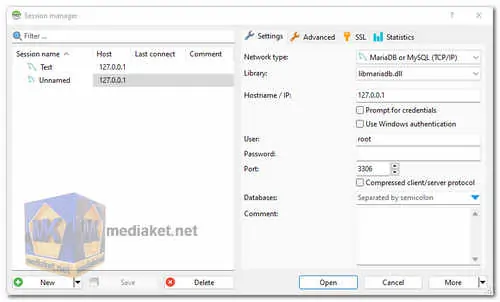HeidiSQL is an open-source database management tool designed for Windows, offering a user-friendly interface to manage and interact with various database systems, including MariaDB, MySQL, Microsoft SQL Server, PostgreSQL, and SQLite. It is known for its ease of use and a wide range of features that cater to database administrators, developers, and other professionals...
HeidiSQL is free-to-use database management tool that simplifies the process of managing and working with different database systems. It is designed for Windows and provides an intuitive and user-friendly interface, making it accessible to a wide range of users, from beginners to experienced database professionals.
HeidiSQL key features:
- Free and Open Source: HeidiSQL is free to use for everyone and is an open-source software, which means it can be customized and extended by the community.
- Multi-Server Support: You can connect to multiple database servers within a single window, making it easy to manage databases from different sources.
- Supported Database Systems: HeidiSQL supports various popular database systems, including MariaDB, MySQL, Microsoft SQL Server, PostgreSQL, and SQLite.
- Command Line Access: Connect to database servers via the command line for advanced control and scripting.
- Secure Connections: You can connect via SSH tunnel or configure SSL settings for secure communication with the database servers.
- Schema Management: Create and edit tables, views, stored routines, triggers, and scheduled events within your databases.
- SQL Export: Generate SQL exports of your database structures and data. Compress and save them, or copy them to the clipboard.
- Data Transfer: Easily export data from one server or database and import it into another server or database.
- User Privilege Management: Manage user privileges, roles, and permissions within the supported database systems.
- Import and Export Data: Import data from text files and export table rows in various formats, including CSV, HTML, XML, SQL, LaTeX, Wiki Markup, and PHP Array.
- Grid-Based Data Editing: Browse and edit table data using a comfortable grid interface.
- Bulk Table Operations: Perform batch operations on tables, such as moving to a different database, changing the storage engine, and collation settings.
- Bulk Data Insertion: Insert ASCII or binary files into tables in bulk.
- SQL Query Editor: Write and execute SQL queries with customizable syntax highlighting and code completion.
- SQL Reformatting: Reformat disordered SQL statements to improve readability.
- Process Monitoring: Monitor and terminate client processes running on the database server.
- Text Search: Find specific text within tables across all databases on a single server.
- Table Optimization and Repair: Optimize and repair tables in a batch manner to improve database performance.
- Parallel Command Line Access: Launch a parallel mysql.exe command line window using your current connection settings.
- And More: HeidiSQL offers additional features and tools for managing and interacting with your databases.
Compatibility Notes:
- HeidiSQL is compatible with Windows 8 and 10, and it can run on Windows 7 with minor issues.
- Running HeidiSQL on newer Wine releases (for compatibility with Linux and macOS) may be unstable, and using Wine 4.0 is recommended to resolve various issues.
- Connecting to TLS 1.2 enabled Microsoft SQL Servers requires an updated OLE DB Driver 18 for SQL Server to be installed.
Connecting to PostgreSQL databases may require having the Visual C++ Redistributable Package installed.
HeidiSQL is a versatile and user-friendly database management tool that offers a wide range of features for working with various database systems, making it a popular choice among database administrators and developers.
HeidiSQL - Changelog.
How to use HeidiSQL:
Here's a step-by-step guide on how to use HeidiSQL:
- Download and Install HeidiSQL:
- Download the HeidiSQL installer.
- Run the downloaded installer and follow the on-screen instructions to complete the installation.
- Create a New Connection:
- Open HeidiSQL.
- Click on the "New" button in the bottom left corner.
- In the "Settings" tab, provide your connection details:
- Connection name: Choose a recognizable name for your connection.
- Network type: Select "MySQL (TCP/IP)" for most MySQL databases.
- Hostname/IP: Enter the address of the database server (usually your domain name or server IP).
- Port: The default port for MySQL is 3306, but check with your hosting provider if unsure.
- User: Enter your database username.
- Password: Enter your database password.
- Click the "Save" button.
- Connect to the Database:
- In the main HeidiSQL window, you'll see a list of your saved connections on the left-hand side.
- Select the connection you just created.
- Click the "Open" button, or press Enter.
- Browse and Manage Databases:
- Once connected, you'll see a list of available databases on the server in the main panel.
- Click on a database to see its tables, views, stored procedures, and other objects.
- Working with Tables:
- Right-click on a table to view options like:
- Select data: View and edit table data.
- Structure: View and modify table structure (columns, data types, etc.).
- Insert: Add new data to the table.
- Empty: Remove all data from the table (be cautious!).
- Double-click on a table to open it in the data grid view. Here you can:
- Browse existing data entries.
- Edit existing data by clicking on a cell and modifying the value.
- Add new rows by clicking the "+" icon at the bottom.
- Running SQL Queries:
- Click on the "Query" tab.
- Write your SQL queries in the editor. HeidiSQL offers code completion and syntax highlighting for easier writing.
- Click the "Run" button (blue play icon) or press F9 to execute the query.
- The results of the query will be displayed below the editor.
- Additional Features:
- HeidiSQL offers many other features like:
- Importing and exporting databases.
- Creating and managing database users.
- Setting up database backups.
- Visualizing table structures.
Learning Resources:
- Explore the official HeidiSQL documentation for a more comprehensive guide.

